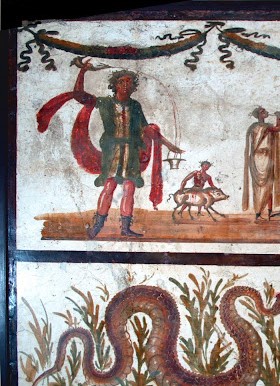
Sculpture en bronze patiné représentant une femme à moitié vêtue d’une draperie, chaussée de sandales. Elle retient de la main gauche sa draperie entre ses seins et son bras droit levé tient un rython.
C’est dans les fresques de Pompeï et dans la statuaire romaine que l’on trouve la représentation de ce que l’on appelle « le lare ». C’est une divinité protectrice du foyer : ces divinités étaient en principe plusieurs dont leur dénomination usuelle de « dieux lares ». Ovide dans les Métamorphoses évoque ces dieux portant tunique et sandales répandant la prospérité dont le rython est l’emblème. Ils sont la plupart du temps associés à Vesta gardienne du foyer.
Au XIXe siècle pour beaucoup d’artistes, l’archéologie est au centre des préoccupations esthétiques. A la suite de Caylus, de Winckelmann, l’école française d’Athènes est créée en 1846, et le musée grec primitif du Louvre ouvre en 1849 exposant les statues antiques.
Cette statuaire incarne l’idée du Beau et inspire les artistes sculpteurs de ce siècle. Notre sculpture est tout à fait dans ce mouvement artistique du retour à l’antique tout en l’adaptant aux nouveaux codes de l’esthétique.
Rython : vase à boire en forme de corne, l’extrémité terminée par une tête d’animal. Utilisé lors de libation. Dans l’antiquité il était donné aux dieux et aux héros.








